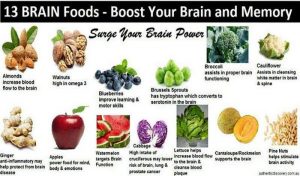 North Shore Dance Society
North Shore Dance Society
One of the most amazing things about dancing is that it uses and develops so many things that are important in enhancing the quality of one’s life. Dancing is physical, emotional, creative, challenge oriented and social. None of this is possible however without the mental focus, and mental focus, of course, is not possible without the right nutrition.
Mental focus requires a healthy brain. Your brain is part of your body, and is the part that is most immediately responsive to what you eat.
Our brain weighs about 2 percent of our body weight, but uses about 20 percent of our daily calories.
The brain is also a bit finicky. It is the first part of your body to falter it is does not have a steady stream of the right kind of fuel. Consider the fact that there are two types of physical hunger, each with a very different impact on you. If your stomach is empty, you can probably still do what you need to do, even if it is uncomfortable. If your brain does not have fuel, anything you do will be very difficult, slow or even impossible.
The brain is also sensitive to your level of neurotransmitters. Neurotransmitters are brain chemicals such as serotonin and dopamine. The brain uses neurotransmitters to tell your heart to beat, your lungs to breathe, and your stomach to digest. Neurotransmitters also affect anxiety level, motivation, mood, sleep, pain tolerance, concentration and even coorodination. Many things can impact your neurotransmitters including stress, toxins, genetics, drugs and yes … diet.
It is clear that you need to feed your brain properly. So, what kind of diet does your brain really need?
Glucose
Glucose is what your brain consumes as fuel, but the source of glucose makes a big difference.
The primary source of glucose should be from complex carbohydrates such as oatmeal (which is gluten free) or other whole grains.
Complex carbohydrates also increase your brain’s production of serotonin, which will help to keep anxiety down.
“Brown” grains with a low glycemic index are the best type of complex carbohydrate for your brain, since they release glucose slowly and keep you focused longer.
Simple carbohydrates in sugars and fruit juices are OK, but in small doses since they will give you a short term boost, then a big let down.
Protein
In addition so several other benefits, protein helps you avoid mood and energy swings by slowing down the digestion of both simple and complex carbs.
Protein also increases your brain’s production of dopamine, which helps you to concentrate, and is the neurotransmitter most closely associated the coordination and the ability to experience pleasure.
Great proteins also have more than one benefit.
Eggs have the benefit of choline which may help learning and slow memory loss due to aging.
Sardines, salmon, trout and other fatty fish have omega-3 fatty acids, which are important for brain function. DHA, one type of omega-3 in fatty fish, is present in your right in the brain. Low DHA levels have been linked to a higher risk of developing Alzheimer’s disease and memory loss. In addition, the fatty acids in fish go straight to the synapses of nerve cells, in the brain, which helps them function properly in learning and memory.
Oysters are rich in both iron and zinc, which helps prevent short memory lapses and difficulty focusing. Low iron reduces ability to concentrate, and lower levels of zinc slows the ability to recall something you have just heard.
Beans offer the same important glucose stabilizing benefit as animal and fish proteins. Lentils and black beans are particularly good.
Fruits
Fruits are like maintenance tools for the brain. All are valuable in some way, but certain fruits have particularly helpful properties for the brain.
To put it bluntly, berries help prevent brain rust. They have great anti-oxidative compounds like vitamins C, E, beta-carotene, which slow or prevent the damage to your brain cells from free radicals. Free radicals are caused with oxygen interacts with certain molecules and causes oxidation – like rust – which then goes on to damage healthy cells.
Raspberries, strawberries and blueberries have chemicals called ellagatannis in are also found in in the brain’s memory control center.
Blueberries also contain proanthocyanins, which support the place in the brain that is most closely related to spatial memory, which is critical for dancers.
Tomatoes have lycopene, which is another a powerful antioxidant – and, yes, tomatoes are technically a fruit, as are avocados.
Avocados are almost as good as blueberries in promoting brain health, and also have the benefit of monounsaturated fat, which contributes to healthy blood flow.
Nuts
Nuts, seeds and even curry. Nuts and seeds offer a great boost for memory and thinking skills.
Pumpkin seeds are a great source of zinc.
Walnuts, hazelnuts, Brazil nuts, filberts, almonds, cashews, peanuts, sunflower seeds, sesame seeds, flax seed, and unhydrogenated nut butters such as peanut butter, almond butter, and tahini are good sources of vitamin E.
Turmeric, the yellow spice found in many curries, contains curcumin. Curcumin has powerful anti-inflammatory and antioxidant properties which aids mental performance.
Dark-Chocolate
Fifth, and a favorite recommendation for those wth a sweet tooth, is dark chocolate. Dark chocolate has antioxidant properties, is a natural stimulant, and is an endorphin booster.
Found at reflectionsinsequinsandsatin.wordpress
North Shore Dance Society